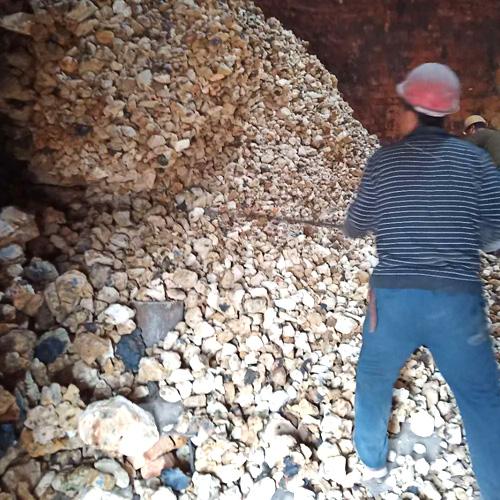
The chemical composition of bauxite is mainly Al2O3, SiO2, Fe2O3, TO2, accounting for about 95% of the total composition, and the secondary components are CaO, MgO, K2O, Na20, S, MnO2 organic matter and trace components Ga, Ge, etc.
Calcined bauxite for refractory material
The chemical composition of bauxite is mainly Al2O3, SiO2, Fe2O3, TO2, accounting for about 95% of the total composition.
Al2O2 is the main chemical component of bauxite, and its occurrence state is mainly aluminum hydroxide, by aluminosilicate, which is clay minerals; in addition, it can also contain a small amount or trace amount in iron and titanium minerals. SiO2- generally exists as clay minerals, and rarely is free stone molybdenum.
Fe2O2 generally exists in the form of hematite in karst or sedimentary bauxite: the primary zone is often pyrite, less siderite, oolitic mud, and rarely magnetite, etc.; Belt (late weathering) and red seven-type bauxite are mainly goethite, others such as water hematite, water goethite and aluminum goethite, aluminum hematite, etc.
Rare. In addition, a small amount of iron often exists in diaspore, boehmite, gibbsite and corundum in a similar form.
The content of TiO2 in bauxite is usually 2%~4%, but there are also higher, which can reach 6%~12%, such as bauxite in southwestern Sichuan and India.
Both titanium and aluminum are inert elements in the process of parent salt weathering, so A/Ti often maintains a constant ratio in each mining area. In bauxite, the independent minerals of T element are mainly anatase and rutile, by brookite, leucite and ilmenite. There are also similar occurrences in aluminum minerals. In addition, it also occurs in other minerals in the form of gels.
S is a very harmful impurity in bauxite, and it generally exists in the form of pyrite. The pyrite content is higher in the acoustic zone of sedimentary or karst bauxite; the sulfur content in the oxidation zone or accumulation bauxite is lower, generally between 0.05% and 0.1.
Physical and chemical indicators of calcined bauxite
|
Project |
Al2O3% |
Fe2O3% |
TiO2% |
CaO+MgO% |
K2O+Na2O% |
Bulk density(g/cm3) |
water absorption |
|
GL-90 |
≥89.5 |
≤1.5 |
≤4.0 |
≤0.35 |
≤0.35 |
≥3.35 |
≤2.5 |
|
GL-88A |
≥87.5 |
≤1.6 |
≤4.0 |
≤0.4 |
≤0.4 |
≥3.20 |
≤3.0 |
|
GL-88B |
≥87.5 |
≤2.0 |
≤4.0 |
≤0.4 |
≤0.4 |
≥3.25 |
≤3.0 |
|
GL-85A |
≥85 |
≤1.8 |
≤4.0 |
≤0.4 |
≤0.4 |
≥3.10 |
≤3.0 |
|
GL-85B |
≥85 |
≤2.0 |
≤4.5 |
≤0.4 |
≤0.4 |
≥2.90 |
≤5.0 |
|
GL-80 |
>80 |
≤2.0 |
≤4.0 |
≤0.5 |
≤0.5 |
≥2.90 |
≤5.0 |
|
GL-70 |
70~80 |
≤2.0 |
- |
≤0.6 |
≤0.6 |
≥2.75 |
≤5.0 |
|
GL-60 |
60~70 |
≤2.0 |
- |
≤0.6 |
≤0.6 |
≥2.65 |
≤5.0 |
|
GL-50 |
50~60 |
≤2.5 |
- |
≤0.6 |
≤0.6 |
≥2.55 |
≤5.0 |
The use of calcined bauxite:
(1) Aluminum smelting industry. For, aviation, automobiles, electrical appliances, chemicals, daily necessities, etc.
(2) Precision casting. The bauxite clinker is processed into fine powder to make a mold and then precision cast. For medical, aerospace, communications, instrumentation, machinery and medical equipment sectors.
(3) For refractory products. High alumina bauxite clinker has a refractoriness of up to 1780℃, strong chemical stability and good physical properties.
(4) Aluminum silicate refractory fiber. It has the advantages of light weight, high temperature resistance, good thermal stability, low thermal conductivity, small heat capacity and mechanical vibration resistance. For steel, non-ferrous metallurgy, electronics, petroleum, chemical, aerospace, atomic energy, and other industries. It is to put high-alumina clinker into a high-temperature electric arc furnace with a melting temperature of about 2000-2200 ° C, and after high-temperature melting, high-pressure high-speed air or steam injection, and cooling, it becomes white "cotton" - aluminum silicate refractory fiber. It can be pressed into fiber blanket, board or woven into cloth to replace refractory bricks lining high temperature furnaces in smelting, chemical, glass and other industries. Firefighters can use fire-resistant fiber cloth to make clothes.
(5) Using magnesia and bauxite clinker as raw materials, adding appropriate binder, it is very effective for pouring the overall lining of the ladle.
(6) Manufacture of various compounds of alumina cement, abrasive materials, ceramic industry and chemical industry that can make aluminum.
In recent years, bauxite powder and bauxite have been widely used in common cast steel coatings and cast iron coatings due to their high fire resistance, good chemical stability, small expansion coefficient, rich source and low price.
Fireclay bricksis suitable for supporting hot blast stoves of large, medium and small blast furnaces
Yuying Refractory produces a complete set of refractories for electrolyzers, and the new impermeable bricks are used in conjunction with impermeable castables
Refractory carstables for ladles is made of high-purity fused corundum as the main material, high-purity spinel is added to the matrix, and an appropriate amount of binder and admixture (dispersant, water reducing agent) are added.
Magnesia alumina bricks use periclase as the main crystal phase and magnesia-alumina spinel as the matrix. They are better in thermal shock resistance than magnesia bricks. In order to improve the thermal shock resistance of magnesia bricks, alumina or alumina is introduced into the ingredients. Bauxite clinker fine powder to form a magnesia-alumina sharp stone matrix, thereby making magnesia-alumina bricks
Silica brick: an acidic refractory mainly composed of tridymite, cristobalite and a small amount of residual quartz and glass phases. Its silica content is more than 94%, it has anti-acid slag erosion performance, high high temperature strength, high load softening temperature, long-term use in high temperature flower wells without deformation, but low thermal shock stability (heat exchange in water is 1-4 Second-rate).
Insulation castables are mainly made up of lightweight refractory aggregates, powders, and binder additives.
Refractory castable is a kind of refractory material that does not need to be formed and has good fluidity after being fired and stirred with water.



